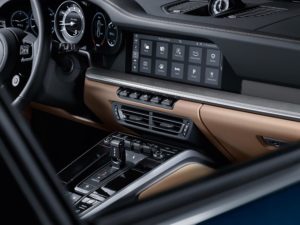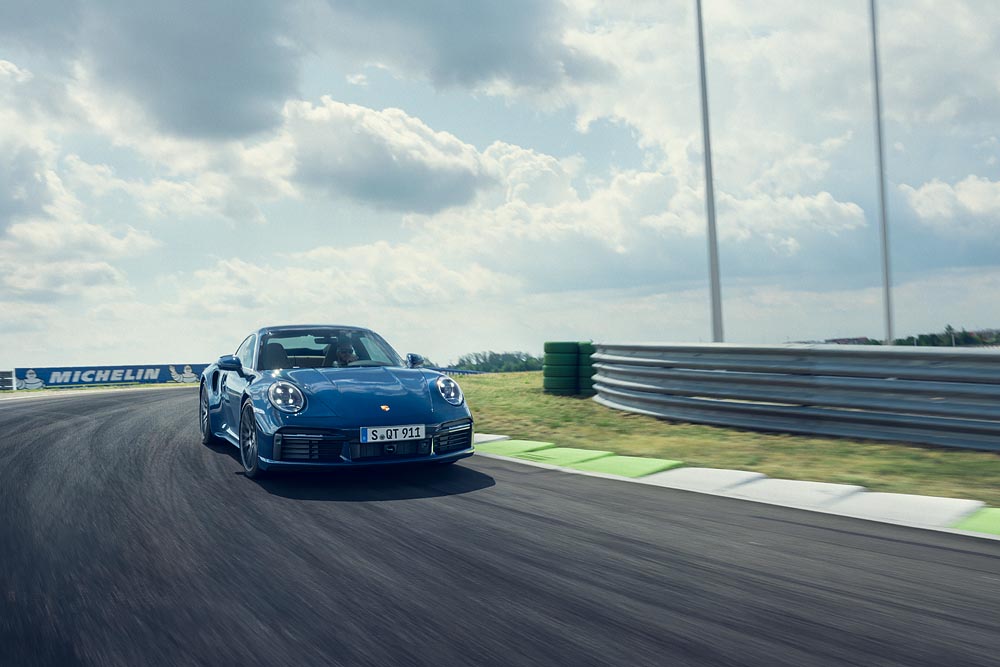The Porsche 911 Turbo has been the quintessential high-performance sports car with everyday usability for the past 45 years.
The next generation 911 Turbo Coupé and Cabriolet are now being introduced and can be described in short as even more powerful, faster and more individual.
Thanks to their 580 PS (427 kW) engines (+40 PS/+30 kW), both model variants dip under the three-second 0-100 km/h mark with a time of 2.8 seconds (-0.2 seconds).
Now without an overboost time limit, 750-newton metres of torque (+40 Nm) make quick sprints even more spontaneous and effortless.
Acceleration, power output and torque of the new 911 Turbo all match those of the previous generation 911 Turbo S.
Power transmission is performed by an eight-speed PDK gearbox with a Turbo-specific set-up, while its top speed remains unchanged at 320 km/h.
With an increased range of options, such as the Sports and Lightweight Design packages, sports chassis and sports exhaust system, customers are able to adapt their vehicle to their individual tastes even more.
The new 911 Turbo’s 3,745 cm3 six-cylinder boxer engine boasts an increased output of 580 PS and now features symmetrical VTG turbochargers with electrically controlled bypass valves.
In conjunction with its redesigned charge air cooling system and the use of piezo injectors, this improves responsiveness, performance, torque characteristics and its ability to rev freely.
The chassis and body have become wider. The front axle now steers even more precisely thanks to an additional 42 millimetres of front track width and new 20-inch 255/35 tyres.
The active all-wheel control Porsche Traction Management (PTM) is now able to transfer even more power to the front wheels, while traction at the actively steered rear axle is increased by a 10 mm-wider track as well as 315/30 tyres on 21-inch wheels.
The revamped braking system is even more powerful and can be recognised by its red fixed callipers that are fitted as standard.
The grey cast iron brake discs at the front now measure 408 mm in diameter (+28 mm) and are 36 mm thick (+2 mm).
The rear axle features 30 mm-thick brake discs with a diameter of 380 mm.
For the first time, customers can opt for a sports exhaust system and choose between two different chassis variants.
While the standard Porsche Active Suspension Management (PASM) chassis offers a greater spread between sportiness and comfort, the significantly firmer, electrically controlled 10 mm-lower sports suspension further enhances the agility of the new 911 Turbo.
Its set-up is aimed at enhancing the car’s dynamics and provides even more stability during high-speed intervals.
The optional hydraulic active anti-roll stabilisation (Porsche Dynamic Chassis Control known as PDCC) and the Porsche Ceramic Composite Brake system with ten-piston fixed callipers at the front refine the new model’s driving dynamics yet further.
The design of the 911 Turbo has become even more muscular. The body has been widened by 45 mm to 1,840 mm at the front wheels to accommodate the new chassis, while the new bonnet’s striking swage line underlines the car’s sporty character.
LED headlights with Porsche Dynamic Light System Plus illuminate the road as standard.

At the rear axle, the body is now exactly 1.90 metres wide (+20 mm).
Other distinguishing features of the new 911 Turbo are its enhanced adaptive aerodynamics, which feature electronically controlled cooling air flaps at the front, its larger active front spoiler and significantly larger variable rear spoiler.
The characteristic air intakes on the rear side panels now draw in-process air rather than the cooling air they did before.
The charge air coolers are now positioned directly in the airflow under the rear lid. The continuous light bar with its LED taillights, as well as the new louvred rear lid grille with silver trim strips, round off the design of the rear of the car.
The appearance and performance of the vehicle can be additionally modified by the optional Lightweight Design and Sports packages.
The Lightweight Design package for the Coupé reduces the vehicle’s weight by 30 kilograms.
Among other things, this is made possible by the use of lightweight full-bucket seats, the omission of the rear seats and the fitting of less insulation, which also means that drivers can enjoy the sound of the engine even more directly.
The Sports package features the 911 Turbo Sport Design package as well as additional features in Black and in Carbon, in addition to Exclusive Design tail lights.
The modern interior relates to the 911 Carrera models with Porsche Advanced Cockpit and Direct Touch Control.
The centre screen of the Porsche Communication Management (PCM) is now 10.9 inches and can be operated quickly and without distraction thanks to its architecture.
The particularly high-quality and extensive equipment list includes fully electrically controlled 14-way sports seats, Sport Chrono package, GT sports steering wheel with shift paddles as well as the powerful BOSE® Surround Sound System.
The new sports cars are following in prestigious footsteps, as the 911 Turbo has been synonymous with luxury and performance since 1975.
Each generation has continued to live up to the claim of being a global benchmark for high-performance sports cars. The 911 Turbo combines sportiness with everyday usability, emotive dynamism with reliability and exhilarating performance with efficiency.
The latest generation of the two-plus-two seater is more than twice as powerful as the original Turbo, which was powered by a three-litre, single-turbocharged, 260 PS flat-six.
While the 911 Turbo may have become faster, larger and more comfortable over the years, it has always retained its fundamental characteristics.
The new 911 Turbo Coupé and Cabriolet models are available for order now. Information on the basic retail price, model specifications and local availability can be obtained at the nearest Porsche Centre.
READ ALSO: Mitsubishi Motors set to host the First-Ever Virtual Car Launch in Nigeria
The fuel consumption and CO2 emission values were calculated according to the new Worldwide Harmonised Light Vehicle Test Procedure (WLTP).
The NEDC values derived from this must continue to be specified for the time being. These values cannot be compared with the values calculated on the basis of the previously used NEDC test.
Further information on the official fuel consumption and official, specific CO2 emissions of new passenger cars is available in the publication entitled “Guidelines on fuel consumption, CO2 emissions and power consumption of new passenger cars”, which is available free of charge from all sales outlets and from Deutsche Automobil Treuhand GmbH (DAT).













